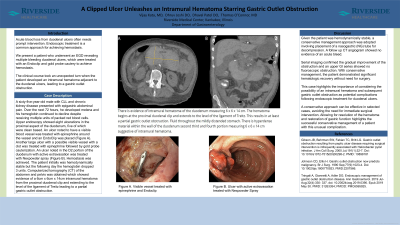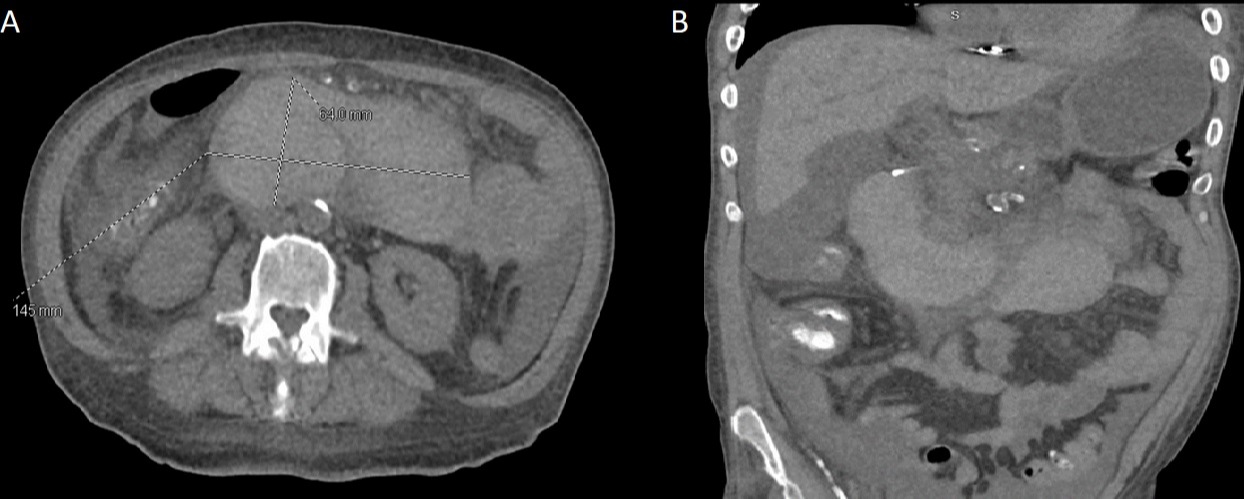Sunday Poster Session
Category: GI Bleeding
P0652 - A Clipped Ulcer Unleashes an Intramural Hematoma Starring Gastric Outlet Obstruction
Sunday, October 22, 2023
3:30 PM - 7:00 PM PT
Location: Exhibit Hall

Has Audio
- DP
Dhaval Patel, DO
Riverside Medical Center
Kankakee, IL
Presenting Author(s)
Dhruv Joshi, DO, Dhaval Patel, DO, Vijay Kata, MD, MS, Thomas O'Connor, MD
Riverside Medical Center, Kankakee, IL
Introduction: Acute blood loss from duodenal ulcers often needs prompt intervention. Endoscopic treatment is a common approach for achieving hemostasis. We present a patient who underwent EGD revealing multiple bleeding duodenal ulcers, which were treated with an Endoclip and gold probe cautery to achieve hemostasis.The clinical course took an unexpected turn when the patient developed an intramural hematoma adjacent to the duodenal ulcers, leading to a gastric outlet obstruction.
Case Description/Methods: A 65 year old male with CLL and chronic kidney disease presented for epigastric abdominal pain. Over the next 72 hours he developed melena and hemoglobin continued to decline despite receiving multiple units of packed red blood cells. Upper endoscopy showed eight ulcerations in the proximal aspect of the duodenum, five of which were clean based. An ulcer noted to have a visible blood vessel was treated with epinephrine around the vessel and EndoClip placed. A large ulcer with a possible visible vessel with clot was treated with epinephrine followed by gold probe cautery. An ulcer noted in the D2 portion of the duodenum with active extravasation was treated with Nexpowder spray. Hemostasis was achieved. He stayed hemodynamically stable however the following day the hemoglobin dropped 3 units. Computerized tomography (CT) of the abdomen and pelvis was obtained which showed evidence of a 6x5x14cm intramural hematoma from the proximal duodenal clip and extending to the level of the ligament of Treitz leading to a partial gastric outlet obstruction.
Discussion: Given the stable hemodynamic status, a conservative management approach was adopted, involving placement of a nasogastric (NG) tube for decompression. A follow up CT angiogram showed no evidence of acute bleed. Serial imaging confirmed the gradual improvement of obstruction and an upper GI series performed showed no fluoroscopic obstruction. With conservative management, the patient demonstrated significant hematologic recovery without need for surgery. This case highlights the importance of considering the possibility of intramural hematoma and subsequent gastric outlet obstruction as potential complications following endoscopic treatment for duodenal ulcers. A conservative approach can be effective in selected cases, avoiding the need for immediate surgical intervention. Allowing for resolution of the hematoma and restoration of gastric function highlights the successful conservative management of a patient with this unusual complication.

Disclosures:
Dhruv Joshi, DO, Dhaval Patel, DO, Vijay Kata, MD, MS, Thomas O'Connor, MD. P0652 - A Clipped Ulcer Unleashes an Intramural Hematoma Starring Gastric Outlet Obstruction, ACG 2023 Annual Scientific Meeting Abstracts. Vancouver, BC, Canada: American College of Gastroenterology.
Riverside Medical Center, Kankakee, IL
Introduction: Acute blood loss from duodenal ulcers often needs prompt intervention. Endoscopic treatment is a common approach for achieving hemostasis. We present a patient who underwent EGD revealing multiple bleeding duodenal ulcers, which were treated with an Endoclip and gold probe cautery to achieve hemostasis.The clinical course took an unexpected turn when the patient developed an intramural hematoma adjacent to the duodenal ulcers, leading to a gastric outlet obstruction.
Case Description/Methods: A 65 year old male with CLL and chronic kidney disease presented for epigastric abdominal pain. Over the next 72 hours he developed melena and hemoglobin continued to decline despite receiving multiple units of packed red blood cells. Upper endoscopy showed eight ulcerations in the proximal aspect of the duodenum, five of which were clean based. An ulcer noted to have a visible blood vessel was treated with epinephrine around the vessel and EndoClip placed. A large ulcer with a possible visible vessel with clot was treated with epinephrine followed by gold probe cautery. An ulcer noted in the D2 portion of the duodenum with active extravasation was treated with Nexpowder spray. Hemostasis was achieved. He stayed hemodynamically stable however the following day the hemoglobin dropped 3 units. Computerized tomography (CT) of the abdomen and pelvis was obtained which showed evidence of a 6x5x14cm intramural hematoma from the proximal duodenal clip and extending to the level of the ligament of Treitz leading to a partial gastric outlet obstruction.
Discussion: Given the stable hemodynamic status, a conservative management approach was adopted, involving placement of a nasogastric (NG) tube for decompression. A follow up CT angiogram showed no evidence of acute bleed. Serial imaging confirmed the gradual improvement of obstruction and an upper GI series performed showed no fluoroscopic obstruction. With conservative management, the patient demonstrated significant hematologic recovery without need for surgery. This case highlights the importance of considering the possibility of intramural hematoma and subsequent gastric outlet obstruction as potential complications following endoscopic treatment for duodenal ulcers. A conservative approach can be effective in selected cases, avoiding the need for immediate surgical intervention. Allowing for resolution of the hematoma and restoration of gastric function highlights the successful conservative management of a patient with this unusual complication.

Figure: There is evidence of intramural hematoma of the duodenum measuring 6 x 6 x 14 cm. The hematoma begins at the proximal duodenal clip and extends to the level of the ligament of Treitz. This results in at least a partial gastric outlet obstruction. Fluid throughout the mildly distended stomach. There is hyperdense material within the wall of the duodenum second third and fourth portion measuring 6 x 6 x 14 cm suggestive of intramural hematoma.
Disclosures:
Dhruv Joshi indicated no relevant financial relationships.
Dhaval Patel indicated no relevant financial relationships.
Vijay Kata indicated no relevant financial relationships.
Thomas O'Connor indicated no relevant financial relationships.
Dhruv Joshi, DO, Dhaval Patel, DO, Vijay Kata, MD, MS, Thomas O'Connor, MD. P0652 - A Clipped Ulcer Unleashes an Intramural Hematoma Starring Gastric Outlet Obstruction, ACG 2023 Annual Scientific Meeting Abstracts. Vancouver, BC, Canada: American College of Gastroenterology.
